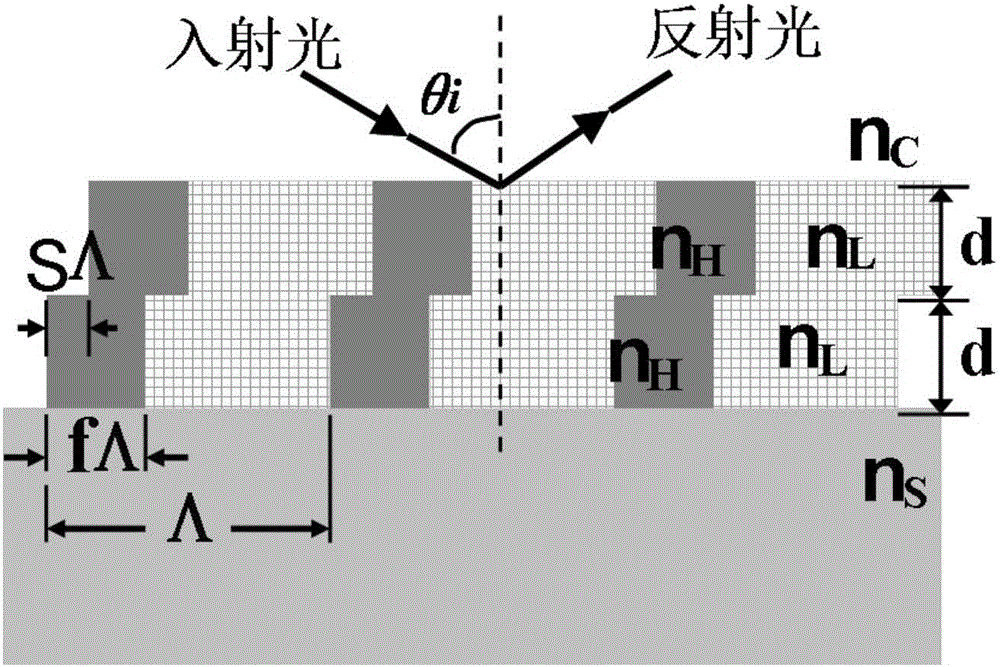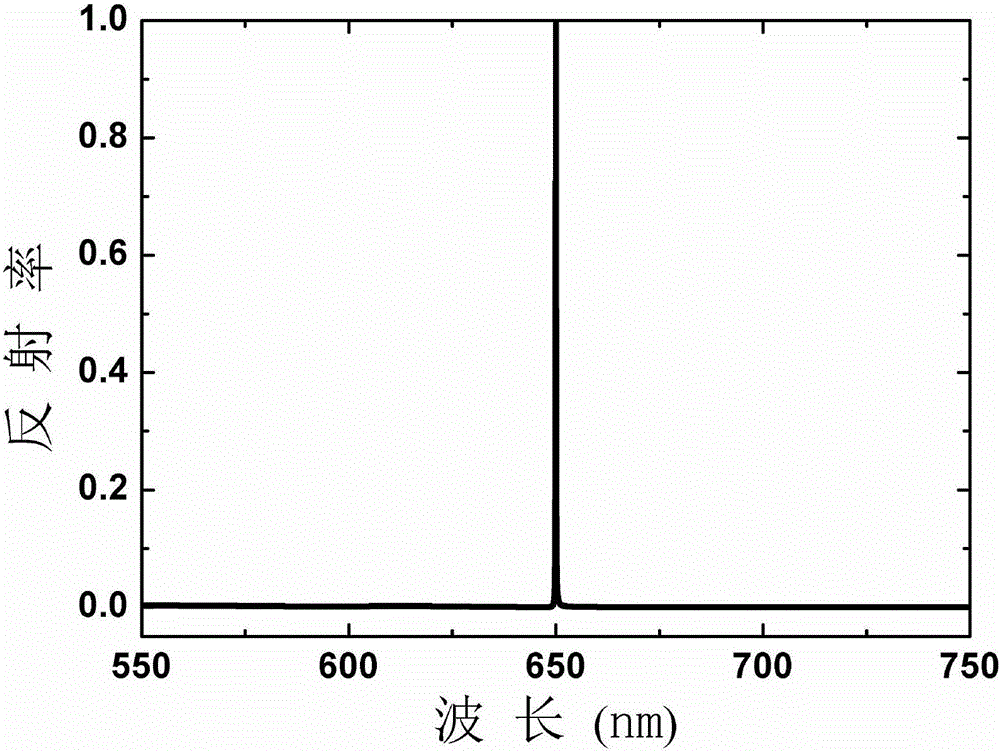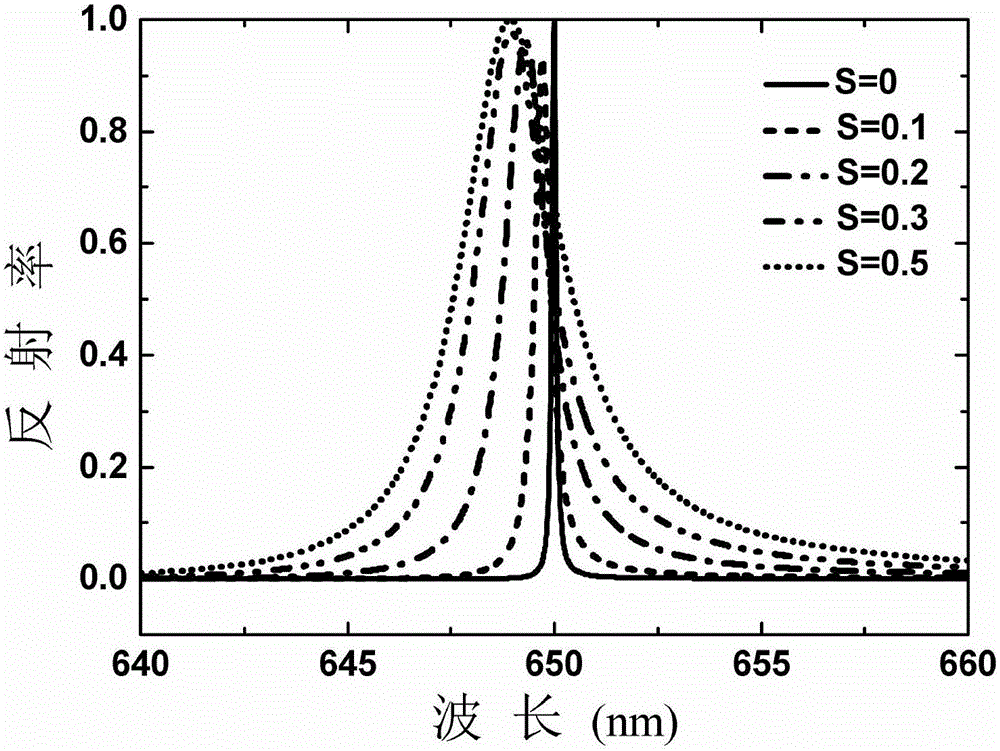Method for dynamically controlling reflection spectrum bandwidth of guided-mode resonance filter
A guided-mode resonance and filter technology, which is applied in the fields of optical communication and micro-electromechanical systems, can solve problems such as the size of a single spectral bandwidth and the dynamic adjustment of the spectral bandwidth of a guided-mode resonance filter.
- Summary
- Abstract
- Description
- Claims
- Application Information
AI Technical Summary
Problems solved by technology
Method used
Image
Examples
Embodiment 1
[0020] Embodiment 1 Designing a Guided Mode Resonant Filter Using a Coupled Grating Structure
[0021] A guided-mode resonant filter is designed by using a coupling grating structure. The coupling grating is composed of two subwavelength gratings stacked up and down with one-half the thickness of the dummy layer. For TM polarized incident light, at the Brewster angle Nearby, the electromagnetic field coupling between the upper and lower two gratings is changed by controlling the relative lateral movement of the two gratings at the micro / nano level, so as to realize the dynamic regulation of the reflection spectral bandwidth of the guided mode resonant filter.
[0022] The design wavelength and material of the filter can be selected according to actual conditions. For TM polarization, select the design wavelength λ = 650nm, using HfO 2 and SiO 2 Two high and low refractive index materials, the refractive indices are: n H = 1.98, n L = 1.46. The incident medium is air n c ...
Embodiment 2
[0023] Embodiment 2 Dynamically adjust the bandwidth of the guided-mode resonant filter based on the coupling grating structure
[0024] Based on the coupling grating structure design of the guided mode resonant filter in Example 1, the reflection filter spectrum curve of the guided mode resonant coupling grating is calculated by vector diffraction theory, and obtained figure 2 From the calculation results, it can be seen that due to the Brewster anti-reflection effect of TM polarization, in the 200nm wavelength range near the design wavelength of 650nm, the sideband reflectance of the filter is lower than 5‰, and the guided mode resonance reflection filter performance superior.
[0025] exist figure 2 Under the parameter condition of , select different grating traversing coefficient S, for example, S is 0.1, 0.2, 0.3, 0.5 respectively, and use vector diffraction theory to calculate the reflection spectrum curve of the guided-mode resonant coupling grating, and get image ...
Embodiment 3
[0026] Example 3 fine-tuning the incident angle to compensate for peak wavelength drift caused by grating traverse
[0027] When the coupling grating based on the embodiment 2 moves laterally, the equivalent refractive index of the coupling grating will change slightly, resulting in a slight shift of the peak position of the filter as S changes. In Example 2, the incident angle θ i=55.59°, when S=0, the peak of the coupling grating corresponds to the design wavelength of 650nm, but when S changes, the peak wavelength will slightly deviate from the design wavelength, for example, if S is 0.1, 0.2, 0.3, 0.5, the peak positions are 649.7nm and 649.3nm respectively , 648.9nm, 649.1nm. For the peak wavelength shift phenomenon caused by the change of S, the compensation for the peak wavelength shift can be realized by fine-tuning the incident angle.
[0028] For example, for S=0.1, use vector diffraction theory to calculate the relationship between filter reflectivity and incident...
PUM
 Login to View More
Login to View More Abstract
Description
Claims
Application Information
 Login to View More
Login to View More - R&D
- Intellectual Property
- Life Sciences
- Materials
- Tech Scout
- Unparalleled Data Quality
- Higher Quality Content
- 60% Fewer Hallucinations
Browse by: Latest US Patents, China's latest patents, Technical Efficacy Thesaurus, Application Domain, Technology Topic, Popular Technical Reports.
© 2025 PatSnap. All rights reserved.Legal|Privacy policy|Modern Slavery Act Transparency Statement|Sitemap|About US| Contact US: help@patsnap.com



